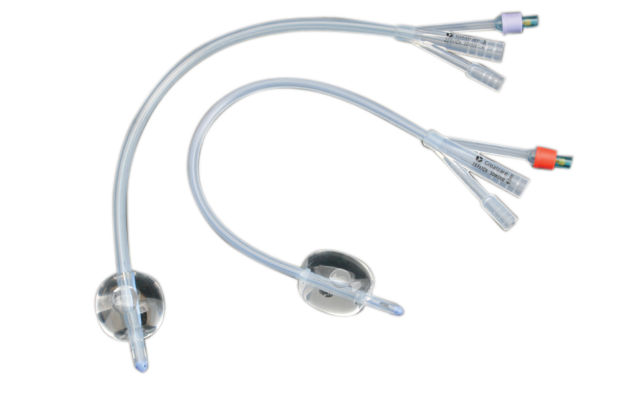
A Foley balloon catheter is a type of medical device that is used to help drain urine from the bladder. It is inserted through the urethra and into the bladder, where the balloon is inflated to help keep the catheter in place. The Foley catheter is then connected to a drainage bag, which collects the urine as it drains from the bladder.
| Ref. No.: | Size: | Balloon capacity: | color: | Qty.Cs: |
|---|---|---|---|---|
| NMU201216 | 16 Fr/ch | 30ML | Orange | 400 |
| NMU201218 | 18 Fr/ch | 30ML | Red | 400 |
| NMU201220 | 20 Fr/ch | 30ML | yellow | 400 |
| NMU201222 | 22 Fr/ Ch | 30ml | Violet | 400 |
| NMU201224 | 24 Fr/ch | 30ml | Blue | 400 |
A three way standard (plastic valve) Foley balloon catheter is a type of urinary catheter that is commonly used to treat bladder problems. The three way refers to the fact that the catheter has three channels: one for draining urine, one for inflating the balloon, and one for withdrawing the catheter. The balloon is inflated to help keep the catheter in place. The plastic valve allows the user to control the amount of urine that is drained.
This type of Foley catheter is often used when there is difficulty urinating due to an obstruction in the urinary tract. It can also be used to help empty the bladder completely after surgery. The three way Standard (plastic valve) Foley balloon catheter is a safe and effective way to treat bladder problems.
When it comes to using a three way Standard (plastic valve) Foley balloon catheter, there are a few things you need to keep in mind. First, always remember to lubricate the outside of the catheter before insertion. Second, insert the catheter into the bladder until urine begins to flow, then inflate the balloon according to manufacturer's instructions. Finally, once the balloon is inflated, remove the syringe and cap the end of the catheter.
A Three Way Standard (plastic Valve) Foley Balloon Catheter is a type of catheter that is inserted into the bladder to help drain urine. It is a common type of catheter used in hospitals and nursing homes. The catheter has a balloon at the end that is inflated with sterile water once it is in place. The balloon helps to keep the catheter in place. There are three ports on the catheter: two for draining urine and one for inflating the balloon.
If you have a Three Way Standard (plastic Valve) Foley Balloon Catheter, it is important to take care of it properly to prevent infection. Here are some tips on how to care for your catheter:
-Wash your hands with soap and water before touching your catheter
-Empty your urinary drainage bag when it is half full or as directed by your healthcare provider
-Clean the urinary drainage bag with soap and water every day
-Keep the area around your catheter clean and dry
-Change your position often to avoid pressure sores
-Do not pull on your catheter or try to remove it yourself, this can cause serious damage